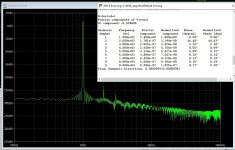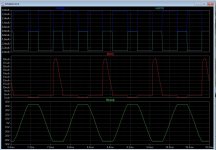Hi EdGr,
Thats the beauty of feedback that for a 4Ohm load in EFII her antagonistic control loops propel the slew rate from 4V/us to 23V/us while knocking a few zeros into that distortion
Thats the beauty of feedback that for a 4Ohm load in EFII her antagonistic control loops propel the slew rate from 4V/us to 23V/us while knocking a few zeros into that distortion
Last edited:
Look at ostripper's Spooky amp. https://www.diyaudio.com/community/...-wolverine-compatible-ips.398785/post-7345320 His amp won't blow up.
Ed
Ed
Thanks Ed, its a beautiful amplifier. Am well versed with Ostrippers work, SYMEF and Honey badger debuted at almost the same time at that time the diyaudio store needed a class AB amplifier, it could have very well been the the SYMEF. However at that time Douglas Selfs blameless amps were all the rave the badger won. Actually this amplifier is the badger and wolverine eater 🤣
For completeness' sake:I thought of something like this, but it needs something extra to protect against destructive latch-up when QCM6 and QCM8 go in saturation.
View attachment 1196017
The latch-up issue is due to the base-collector diodes of QCM8 and QCM6. When there is too much current flowing through QCM3 and QCM4, the base of QCM8 may get so high that its base-collector diode provides base current to Q4 and QCM2 (polarity reversal due to saturation).
If dual transistors are acceptable (some are quite cheap), the simplest solution to the latch-up issue would be using dual matched transistors for QCM7 and QCM8 and their PNP colleagues and getting rid of their emitter resistors. Without emitter resistors, the base is not likely to go high enough for the base-collector diode to provide base current to Q4 and QCM2. One could also think of various clamping and current limiting schemes.
If dual matched transistors are acceptable, you can also make it a product rule class-B loop by replacing RCM3 and RCM4 with diode-connected transistors that match QCM3 and QCM4. You may then have to do something about the difference in dissipation of the transistors, if they are not thermally very well coupled.
Thanks Marcel, your correct, that's a possible state of the circuit, however, the circuit in post 1 doesn't really worry too much about that, it even exploits it and should work really well even with unmatched devices.
Note that Johns amplifier measures well despite being worse offDo you mean you deliberately biased your Q1 and Q10 in saturation?
Actually when people ask me which amplifiers in my range are references for mixing in the studio as well as atmos playback? there's just two
https://www.diyaudio.com/community/threads/1diffqc-amplifier.219354/post-3157371
https://www.diyaudio.com/community/...fier-for-whatever-speaker.401371/post-7404062
https://www.diyaudio.com/community/threads/1diffqc-amplifier.219354/post-3157371
https://www.diyaudio.com/community/...fier-for-whatever-speaker.401371/post-7404062
John is a genius of sorts, according to himself hes a self taught dog with a bone learner. His design is actually perfect. Once the mirror goes into saturation, the VAS becomes another current mirror for the LTP current. Those that live within his vicinity should go have a listen

Good news. I have decided to temporarily open up the design for DIY non commercial purposes, so that you can all get to experience the magic of this amplifier. The design measures 190mm*126mm. Most board houses will ship to you 5 pieces 2oz in red for as low as $114, happy building. You can PM me for paypal address for any patreon gifts you wish to send my way. Check post 1 for files
You use terms like "open up for DIY" and "we" do this and that. Is there a also company that you run?
//
//
There's also the Threshold STASIS project here on diyAudio, and the Pass AB100, and Bob Cordell's BC-1, and the FH9HVX.
"Wolverine / Badger eater" ???
How about an "everything eater" .... 😉 (below)
But you can't even be a "anything eater" if it goes up it in smoke !
Second att. is gross overload , no saturation at base ... 18mA on the 3V cascoded VAS (.1W).
VAS cascode Ic goes to zero - self clamping. Still use clamping diodes at the CM to be safe.
Saturation is NOT good for (anything).... bad bad bad...
Another Fun circuit - cascode LED flashes at clip....
OS
How about an "everything eater" .... 😉 (below)
But you can't even be a "anything eater" if it goes up it in smoke !
Second att. is gross overload , no saturation at base ... 18mA on the 3V cascoded VAS (.1W).
VAS cascode Ic goes to zero - self clamping. Still use clamping diodes at the CM to be safe.
Saturation is NOT good for (anything).... bad bad bad...
Another Fun circuit - cascode LED flashes at clip....
OS
Attachments
- Home
- Amplifiers
- Solid State
- NOT Blameless Amplifier (Red)

